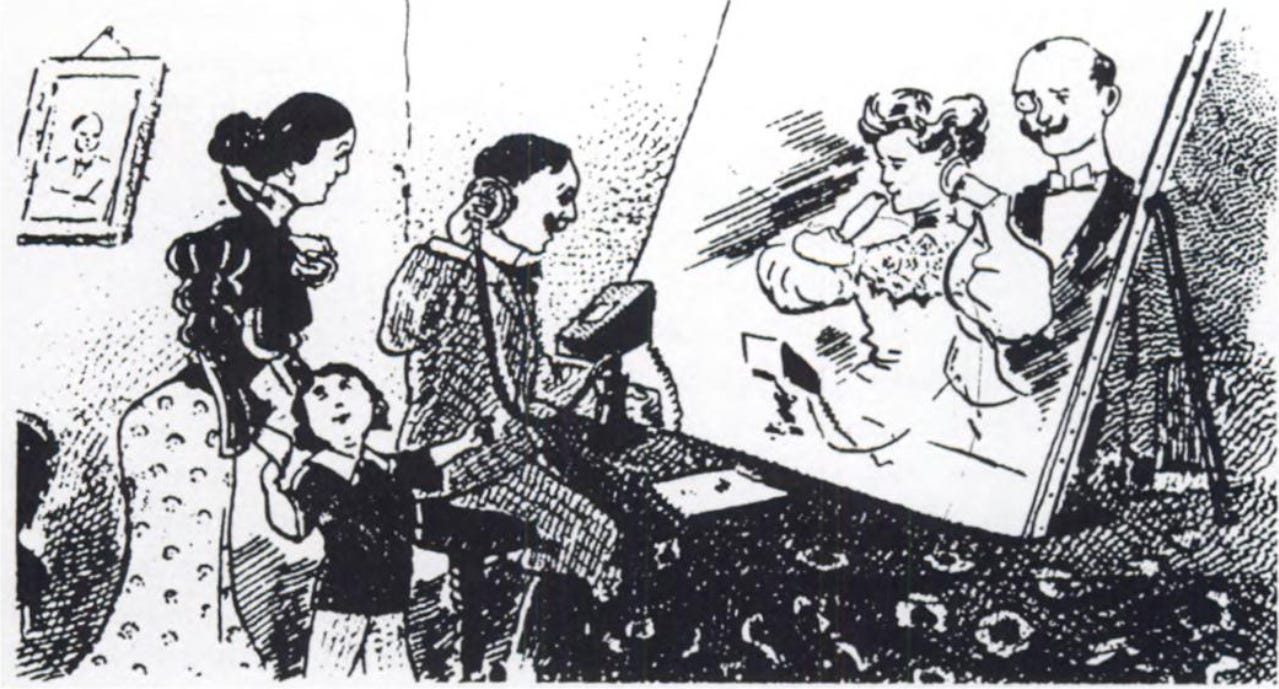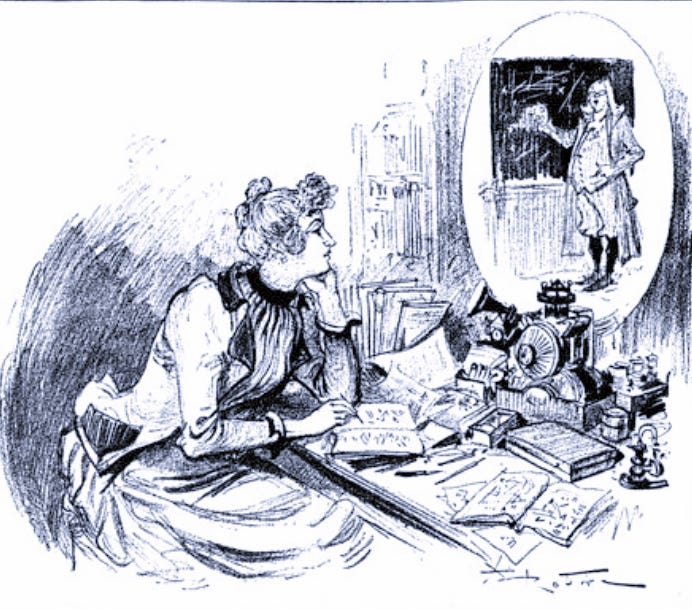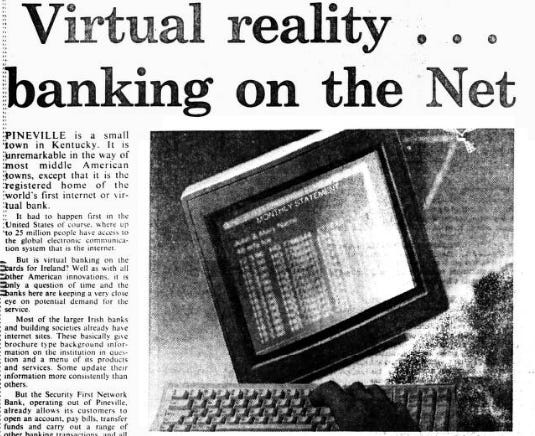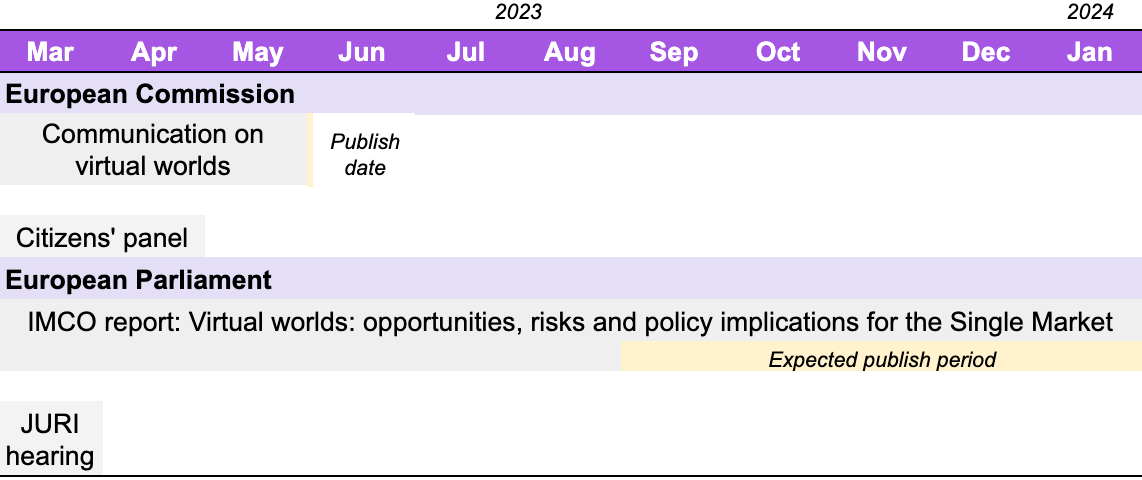Hello and welcome to Metaverse.EU, a monthly newsletter with analysis, policy and news from the EU.
History of a concept
Communicating through time and space used to be tricky. Information had to accompany a messenger or be left in drawings. Using symbols such as hieroglyphics compressed concepts, and with scrolls batches of information could travel on their own.
The codex (from which “code” derives its name) handily tied together scrolls (from which “scrolling” derives). The printing press made producing information easier; the telegraph sent it farther and faster. Still, nothing came close to the richness of spoken word. So in 1876, the telephone arrived. Then things got interesting.
Part I: From Telephone to Television
Not satisfied with the telephone as a means to communicate, people wondered what was next. Some invoked the possibility of ‘seeing by electricity.’


In 1914, reports out of London claimed a Parisian man had invented the “telephote,” a device that wired images and had thus “solved for vision the problems that the telephone has solved for the ear.” Decades passed before anything close to a “telephote” actually arrived. Even then, it sent information one-way and was named the “television.”
Part II: Early Machinations of the Metaverse
Unless everyone owned TV stations, television did not cut it as a means to communicate. But then came the internet: a web of computer networks capable of sharing information not only one-to-one but one-to-many and many-to-many.

In this new reality, interactions could happen ‘online’ and forums hosted global conversations. One paper even gloated the possibility of a “virtual shopping mall,” where customers could connect with retailers without leaving home.
Part III: The Best of Both Worlds
The true “telephote” finally arrived with Skype in 2003 and portably since the iPhone first donned a front camera in 2010. As well as virtual shopping malls, many other interactions started to occur through a new web of screens.
But sharing information this way has drawbacks. Small viewing portals waste most of a human’s field of vision and neglect other senses entirely. Interaction is often limited to thumbing or scrolling—forgoing eye contact, facial expressions, and gestures.
Gradually, though, more of the online world spilt into the real and more of the real appeared online. In this future, people enjoyed the creativity and convenience of new virtual worlds without trading the immersive and interactive features of the real.
Into the EU metaverse…
Policy
The European Commission delayed its communication on the metaverse to 31 May.
A citizens’ panel will inform the Commission’s work, by developing a set of guiding principles. Analysis of the panel’s first session here. Takeaways:
The exercise was an innovation in democratic policymaking and citizens were left excited by the metaverse.
But—the audience did not get enough time to contest ideas, and the Commission’s influence on the process undermines its output.
New EU-funded study: Extended reality: opportunities, success stories and challenges in health and education.
At a Sharing Cities Alliance 🇳🇱 event, the head of the EU’s metaverse work endorsed private-public partnerships: “we are regulators, but we’re also investors.”
Updates on IMCO’s report:
Greens/EFA’s Francisco Guerreiro 🇪🇺🇵🇹 is shadow rapporteur
Renew’s Laurence Farreng 🇪🇺🇫🇷 is rapporteur for CULT committee’s opinion.
France’s 🇫🇷 innovation ministry will lead an interministerial task force on the metaverse and Afnor announced a standardisation commission to develop voluntary standards for the “successor to the Internet.”
EPP’s Axel Voss 🇪🇺🇩🇪 joined a roundtable hosted by Global Counsel, to discuss metaverse business use cases.
Center for Data Innovation’s Patrick Grady 🙋♂️, EPP’s Eva Maydell 🇪🇺🇧🇬, and XR Safety Initiative’s Kavya Pearlman spoke with Politico about the EU’s approach to the metaverse.
Minderoo Foundation announced the eXtended Reality 2030 Policy Fund. The fund will award researchers and civil society leaders who are advancing the next generation of digital media ecosystems to prioritise public interest values.
Business
Last call. 🇪🇺 Metaverse innovators have until 29 March to apply for up to €52 million worth of Horizon Europe funding.
Proof-of-concept. The Commission 🇪🇺 launched a blockchain sandbox to allow up to 20 projects to trail under conditions of regulatory flexibility
Ulterior motif. Louis Vuitton 🇫🇷 partnered with Yayoi Kusama so Snapchat users could virtually cover famous landmarks with the artist’s trademark polka dots.
Virtual insanity. Spotify 🇸🇪 is testing playlists that can be opened with NFTs
GPS 3.0. Audi 🇩🇪 showed off a concept for an immersive pickup truck, featuring a control centre accessible via AR glasses.
Out of the bag. Lynx 🇫🇷 has started to ship its AR mixed-reality headset.
MonzAR. Alpha Romeo 🇮🇹 released a digital twin of their new F1 card that can be observed in augmented reality.
Worked out. Strava acquired Fatmap 🇩🇪, a 3D digital twin builder—“the Google Maps of the great outdoors.”
No Heart No Glory. Following the death of a fan during a match in 2016, Club Brugge 🇧🇪 and Unibet 🇲🇹 launched an AR-based campaign to teach people CPR.
Events
27 Feb– 2 Mar MWC (Barcelona 🇪🇸)13 Mar – 17 Mar Virtuality (Paris 🇫🇷)
28 Mar – 31 Mar Metaverse Fashion Week (virtual)
29 Mar – 31 Mar Immersity (Angoulême 🇫🇷)
5 Apr – 9 Apr NewImages Festival (Paris 🇫🇷)
12 Apr – 16 Apr Laval Virtual (Laval 🇫🇷)
9 May – 10 May NFT Tallinn (Tallinn 🇪🇪)
16 May – 24 May Cannes XR (Paris 🇫🇷)
7 Jun – 8 Jun Non-Fungible Conference (Lisbon 🇵🇹)
12 Jun – 13 June Metaverse Summit (Paris 🇫🇷)
28 Jun – 30 Jun BlockChance (Hamburg 🇩🇪)
5 Jul – 6 Jul Digital Signage Summit (Munich 🇩🇪)
14 Jul – 15 Jul NFT Show Europe (Valencia 🇪🇸)
18 Oct – 20 Oct The Immersion Forum with XR4Europe (Brussels 🇧🇪)
24 Oct – 24 Oct AWE EU (Vienna 🇦🇹)
25 Oct – 26 Oct Metaverse Summit & Awards (Berlin 🇩🇪)
1 Nov – 3 Nov MET AMS (Amsterdam 🇳🇱)
15 Nov – 16 Nov MetaDays (Paris 🇫🇷)
27 Nov – 1 Dec Immersive Tech Week (Rotterdam 🇳🇱)
29 Nov Match XR 2023 (Helsinki 🇫🇮)




